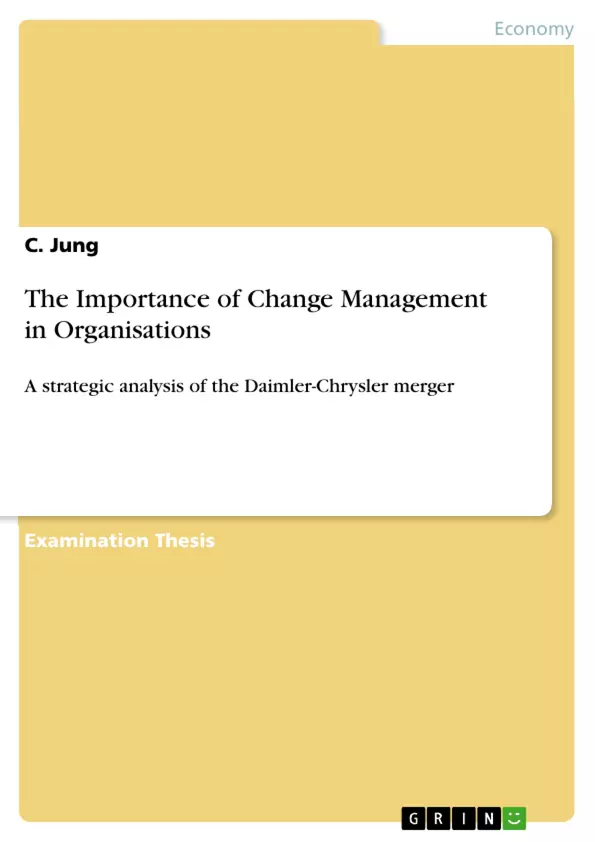1. Introduction
The process of globalization and the intensification of competition, forces modern organizations to adapt themselves quickly and flexibly to changing market conditions. The concept of change by the change management is hence primarily implemented due to economic downturns, economic growth issues, political, societial or technical general conditions or due to the fact that some organizations do not have sufficient internal strength to sustain its position (Lauer, 2010).
By virtue of the merger between the Daimler-Benz AG and the Chrysler Corporation in 1998, the newly created concern DaimlerChrysler tried to build new organizational structures for more efficient competitiveness to expand into new markets and to reinforce it’s financial position, hence taking advantage from a “2+2=5 effect” (Cartwright and Cooper, 1992). Both companies were trying to move from a coordination growth stage to a collaboration growth stage (Clarke, 1994) by the establishment of one single operating entity which as we will see later on, led to the failure of DaimlerChrysler during its “Red Tape crisis” (Greiner, 1972). Goal of the change management was to implement a corporate transformation (Dunphy et al., 1993) by finding the best compromise for both companies in regard to the organizational structure, culture, firm philosophy, operational processes as well as the integration of employees (Waller, 2001).
However, in the course of time a strong antagonism and resistance to the merger arose in particular amongst former Chrysler employees. A study from IBM Global Business Services in 2008 shows that only 41% of all change projects achieve its goals, while 44% only achieve partially the aspired aims and 15% don’t lead to achievement or are abandoned ahead of schedule. The problems of change management adjustments are mostly justified by failures in the acquaintance with the factor human being (IBM Global Business Services, 2008); the partnership between Daimler-Benz and Chrysler also failed due to a primary focus on hard data such as e.g. financial information while forgetting the focus on soft (Cartwright and Cooper, 1995) data namely the support of an organizational culture establishment.
The following report critically evaluates the changes occuring in times of an international merger by the example of the 1998 merger between Daimler-Benz and Chrysler. Beginning with an explanation of the triggers and reasons for the necessity of change
Inhaltsverzeichnis (Table of Contents)
- Introduction
- The Daimler/Chrysler merger
- Two cultures - one company
- The Change Management
- Lewin's Model of Change
- Cultural dimensions
- Recommendation
Zielsetzung und Themenschwerpunkte (Objectives and Key Themes)
This report critically evaluates the changes occurring during an international merger, using the 1998 Daimler-Benz and Chrysler merger as a case study. It analyzes the triggers for change, objectives, changes in organizational structure, leadership, and culture resulting from the German-American collaboration. The report also offers recommendations for overcoming challenges in implementing change during international mergers.
- The necessity of change management in response to globalization and intensified competition.
- Analysis of the Daimler/Chrysler merger as a case study of organizational change.
- The impact of cultural differences on the success of mergers and acquisitions.
- Strategies for effective change management in international mergers.
- Evaluation of the challenges and successes in integrating two distinct corporate cultures.
Zusammenfassung der Kapitel (Chapter Summaries)
Introduction: This chapter sets the stage by discussing the importance of change management in today's dynamic business environment and introduces the Daimler/Chrysler merger as a case study. It highlights the challenges of change management and the low success rate of many change projects.
The Daimler/Chrysler merger: This chapter details the motivations behind the merger, including enhancing Daimler-Benz's competitive position and expanding into new markets. It describes the strategies employed, such as cost optimization through outsourcing and the establishment of a dual headquarters.
Two cultures - one company: This section explores the cultural clashes and challenges inherent in merging two distinct corporate cultures. It delves into the change management strategies employed and assesses their effectiveness in light of the merger's eventual outcome.
Schlüsselwörter (Keywords)
Change management, DaimlerChrysler merger, organizational culture, international mergers, corporate transformation, cultural dimensions, Lewin's model of change, synergy effects, globalization, competition.
- Citation du texte
- C. Jung (Auteur), 2011, The Importance of Change Management in Organisations, Munich, GRIN Verlag, https://www.grin.com/document/183144



